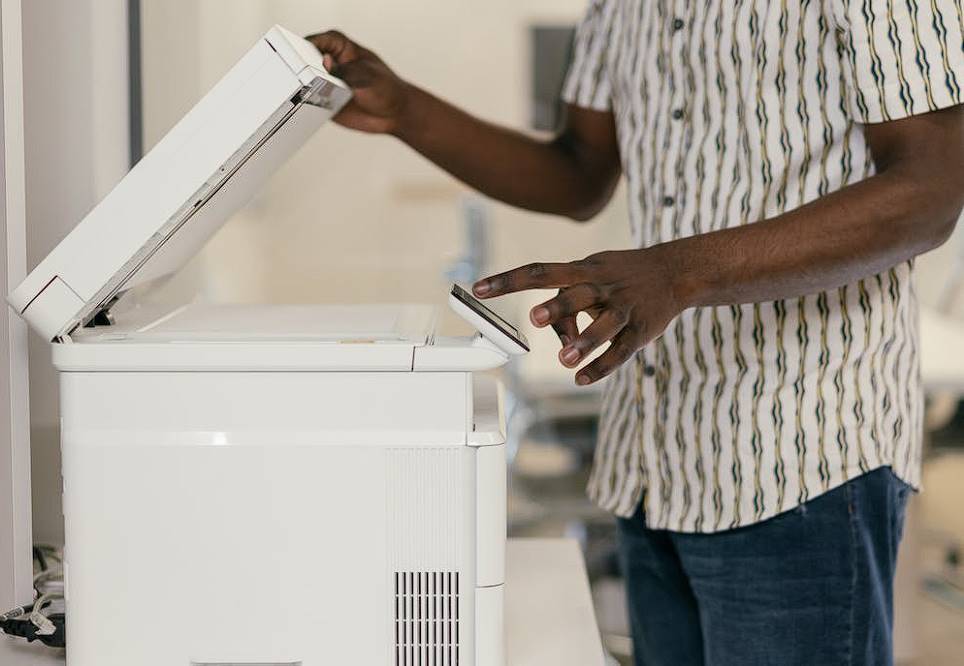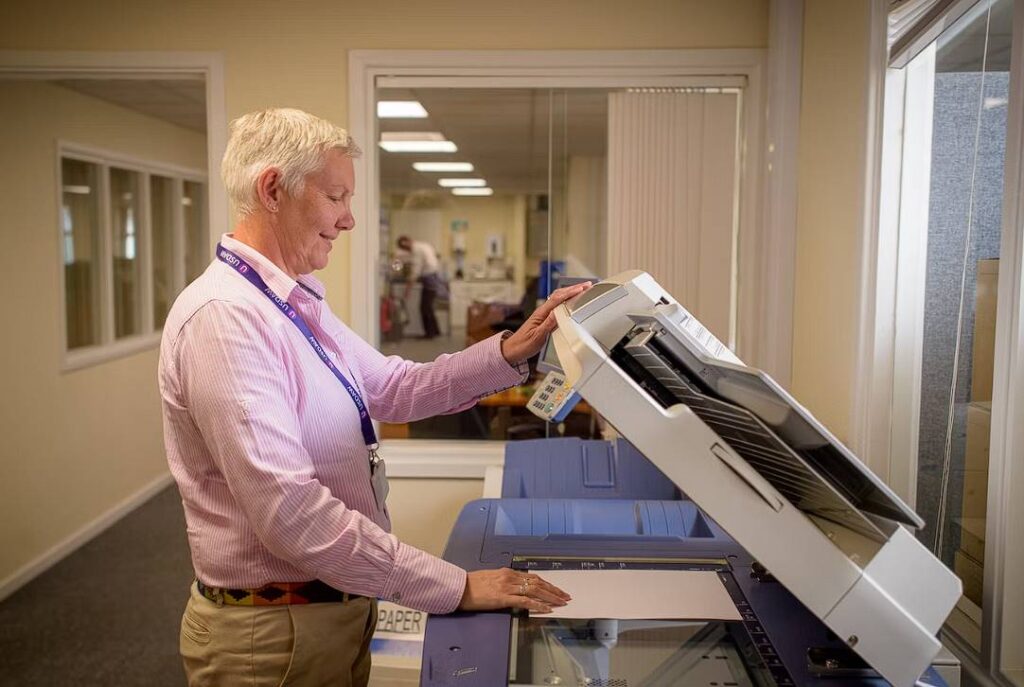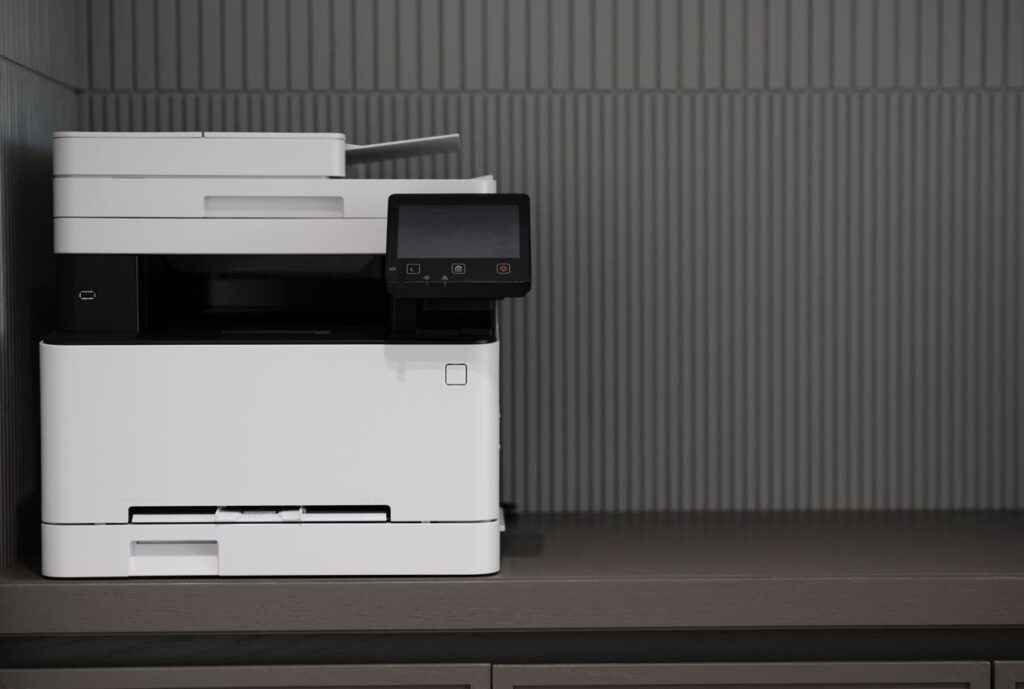Please enjoy this comprehensive guide to maintaining the health of your photocopier. Regular maintenance is essential if you use a photocopier for all printing needs. Inadequate performance, frequent failures, and expensive repairs are all possible outcomes of ignoring maintenance. In this detailed manual, we’ll review everything you need to know about caring for your photocopier. We have you covered for anything from the simplest of cleaning methods to the most complex of malfunctions. Let’s keep your photocopier in tip-top form so it continues serving you well.
How Do I Maintain My Photocopier?
Maintenance of a photocopier entails any measures taken to keep it in good operating order. Preventative maintenance on the photocopier might help you avoid emergency repairs.
All office machinery is susceptible to breakdown without regular servicing. The same can be said of a photocopier.

What is the most common reason for photocopier breakdowns?
Perhaps you’ve wondered, “What causes the most problems with photocopiers?”
Is your copier giving you intermittent problems? There are some possible causes for this.
Here are some of the most typical causes of copier service.
Overheating
A copier, as we’ve mentioned, can serve several purposes. These features may include auto-duplexing as well as mass document duplication and editing.
It’s easy to forget how busy a copier is once you try working with one. If you never allow your copier to cool down in between uses, it will overheat and stop working properly.
When people overextend themselves, illness is a real possibility. A malfunction is possible on a copier if it is not allowed to cool down between uses.
Copier Not The Right Size
The printer’s capabilities are vital, but should they come at the expense of portability? Many workplaces overlook this crucial factor when shopping for a photocopier.
Some photocopiers can’t keep up with the monthly output required. If you put more demands on your copier than it can manage, it will eventually break down.
Problems can arise if you force your copier to produce less than the bare minimum it was built for. A business copier, for instance, is intended for constant, high-volume use, and its misuse can have serious consequences.
Paper Jams
Copier issues might also be caused by something as simple as a paper jam. Where do paper jams come from?
Poor paper quality is a common cause of paper jams. A paper jam may occur if scraps of poor-quality paper build up.
Incorrect paper insertion is another common cause of paper clogs. This is by far the most typical reason for paper clogs. It happens if the paper is inserted incorrectly into the printer.
More paper should be loaded into the input tray. That’s a typical faux pas. Others may cause trouble by folding these papers and jamming them into the tray.
Paper jams can’t be that horrible, right? Okay, but paper jams may wreak havoc on a photocopier’s inner workings. The cost to fix that would be astronomical.
Trouble With The Toner
The toner may be empty or ruined. Cartridges with little capacity are common.
Copies that look faded are an indication that the toner is running low. The old tower would have to be removed and replaced.
By considering these points, you may assist prevent copy problems.
- How well did I set up my toner?
- Is this the proper kind of toner cartridge for my printer?
- Does it work with the photocopier?
Copier problems, such as those caused by a faulty toner cartridge or improper installation, require the attention of a trained professional.
Uneven Density Regulations
Copier issues, especially with too-dark or too-bright printouts, are often the result of uneven density. A high-quality photocopy can be ruined.
This is usually what goes wrong when copies come out too dark or too light. Sometimes the drum is slowly dying.
But if the density control is out of whack, resetting it should fix the problem.
Tips, Tricks, and Fixes for Maintaining Your Office Copier
Take The Copier In For Regular Service And Maintenance
Before anything else, here are some of our favourite ways to make sure your copiers are always smiling:
- Your copier will last longer and use less electricity if you turn it off at the end of the day and on weekends.
- If you last used the copier a few days ago, you should test it by printing a few pages.
- Regular cleaning of the copier is necessary to ensure its continued good functioning. Keep dirt and debris from getting into the machine by wiping away the paper entrance places.
- When clearing jams, make sure to get back everything that got stuck. Leaving even a small piece of paper in the paper path can cause serious problems on the next copy job.
- Just chill out. There’s always a rationale behind a machine’s dysfunction. You can’t make things better by furiously clicking the copy button.
Cleaning The Glass
Keep the rollers and glass surface of the machine dry by cleaning them regularly. Dust and other minute abrasives can scratch glass, so keeping it clean is essential. Use the special spray with the copier or a nonabrasive cloth moistened with glass cleaner to clean the machine.
Removal Of Dust
An effective photocopier is vulnerable to dust. Photocopiers are typically placed in stuffy rooms, so dust quickly accumulates. Dust can be removed from the ink cartridge and surrounding area using a dry paintbrush. A dry dust cloth will do the trick for the major sections of the copy machine. A slightly damp cotton swab can gently clean dust and debris from your ink cartridge.
Changing Out The Toner
Regular toner cartridge replacement is recommended if you produce several copies quickly. If not, you may have to replace the toner well before the current one is empty. The old toner can thicken when exposed to air, drying out or sticking the old ink on the cartridge head. If you want consistent, high-quality prints without a rise in service calls or the cost of replacement parts, you need to use original equipment manufacturer (OEM) toner and parts.

The Ink Cartridge’s Head Is An Often-Forgotten Component.
Take care of the ink cartridge cap even if you neglect the rest of your photocopier. Again, if you don’t keep an eye on the dust and dirt in this area, it can degrade the quality of your copies. Use a damp cotton pad to clean out this area of your body.
Paper Roller Maintenance Is Essential.
Anyone who has ever used a photocopier has probably spent time doing this. The dust on the paper rollers causes the paper to jam since it prevents the paper from moving. Regularly using a lint-free cloth on the paper rollers of your copier will prevent this from occuring.
Copier Streaks: Causes And Remedies
Copies and printouts can sometimes suffer from the appearance of unpleasant streaks and lines. Cleaning the glass may be all that’s needed to remove the streaks. Instead of spraying glass cleaner straight onto the glass, spray it onto a cleaning cloth.
A service call might be necessary if you notice lines on your page that won’t disappear. When you make copies or prints and notice lines, it may be because a roller within the machine is unclean.
In the meantime, try making some blank copies on brand-new paper to see whether the machine picks up any stray toners as it runs. If you want to be proactive, you could attempt washing the “slit glass.” The location of this component on your copier can be found in the user guide.
Even Though Both Of My Printer’s Paper Trays Are Completely Stuffed, The Machine Keeps Telling Me It’s Empty.
The fact that the machine keeps instructing you to load paper despite the obvious presence of paper in the trays is another vexing problem. The paper source can be changed on the copy screen of most machines.
If all paper trays are full, the fault is likely with the task you are sending, such as a picture that is too big for the paper selected or a document that is too big for the paper supplied.
Fixing A Paper Jam
Paper jams are typically simple to fix. Remove the paper by finding the control panel’s blinking light, opening the right door, and following the prompts. Of course, there are occasions where this is not the case.
When a paper jam occurs, open and close the paper drawer as instructed on the screen. Try clearing your queue and sending the jobs again if it doesn’t fix it.
Use Caution
If there’s a paper jam, wait to be tempted to fumble around until you find it; follow the on-screen instructions. Too hasty of disassembly could result in a torn paper that can only be repaired with professional equipment and skill.
What Is Error Code L206?
Many modern photocopiers feature user interfaces as intuitive as those found on smartphones. But occasionally, an error code needs to be clearer or easier to decipher.
Most Canon machines have an error code display that may be accessed by pressing the copy button on the control panel. Some Lexmark machines report an ambiguous “900 Firmware” issue when restarting the printer after being idle or turned off. Most of the time, printing something from a website or dealing with a corrupt print output is to blame. You can send the task again after clearing the print queue.
Don’t just ignore messages like “waste toner reservoir is full.” If you put off emptying it, serious problems could arise (and get messy).
Put The Good Stuff To Use
Using the wrong toner in your copier can result in expensive repairs and possibly even void the warranty on your equipment. The types of toner that work with a given copier can be found in the machine’s user manual. Ensure that everyone in the office is utilising the appropriate tool for the task by consulting with your service provider.
Who Should Be Reached Out To When Copier Needs Repair?
It’s only sometimes a piece of cake to maintain a photocopier. It can be fixed, even though there are pictures in the instructions showing you how to keep it in working order. Here’s where the help of a technician is useful.
When your photocopier breaks down, you’ll need to call in a technician, who may also be referred to as a maintenance person. A technician’s education includes instruction on how to fix copiers.
Conclusion
Maintenance is crucial for maintaining a photocopier, as it is essential for its proper functioning and prevents inadequate performance, frequent failures, and expensive repairs. Common causes of photocopier breakdowns include overheating, not the right size, paper jams, toner issues, uneven density regulations, and improper setup. Overheating can occur due to poor paper quality or incorrect paper insertion, while paper clogs can result from improper paper loading or folding. Toner issues can also arise from faulty cartridges or improper installation. To prevent copy problems, ensure the toner cartridge is the proper kind and compatible with the photocopier. Uneven density regulations can cause issues with too-dark or too-bright printouts, so resetting the density control should resolve the issue.
To maintain a photocopier, turn it off at the end of the day and on weekends, test it by printing a few pages, and regularly clean the machine. Remove dirt and debris from the machine by wiping away paper entrances, and clear jams by removing stuck items. Regularly cleaning the rollers and glass surface is essential to prevent scratches and dust buildup. Regularly cleaning the machine with a special spray or a nonabrasive cloth moistened with glass cleaner can help prevent further issues. Photocopiers are often located in stuffy rooms, making it easy to accumulate dust.
To maintain a clean and functioning photocopier, remove dust from the ink cartridge and surrounding area using a dry paintbrush or a damp cotton swab. Regular toner cartridge replacement is recommended for consistent, high-quality prints without increased service calls or replacement parts costs. The ink cartridge head is often forgotten, so use a damp cotton pad to clean it. Regular paper roller maintenance is essential to prevent paper jams and dust from clogging the rollers.
Copies and printouts may appear with streaks and lines, but cleaning the glass can remove them. If all paper trays are full, the fault may be with the task being sent. If a paper jam occurs, follow the on-screen instructions and wait for the jam to be fixed.
Error codes L206 can be found on most Canon machines by pressing the copy button on the control panel. It is important to use the right toner and consult your service provider for the appropriate tools for the task. If a photocopier needs repair, call a technician, who can also be referred to as a maintenance person.
Content Summary
- Regular maintenance is essential for the health of your photocopier.
- Ignoring maintenance can lead to inadequate performance, frequent failures, and expensive repairs.
- This comprehensive guide covers everything from cleaning methods to complex malfunctions.
- Preventative maintenance helps avoid emergency repairs.
- All office machinery, including photocopiers, is susceptible to breakdown without regular servicing.
- Overheating is a common cause of copier breakdowns.
- Using the copier without allowing it to cool down can lead to malfunctions.
- Choosing the right size copier for your needs is important to avoid breakdowns.
- Putting more demands on the copier than it can handle can cause it to break down.
- Paper jams are a common issue caused by poor paper quality or incorrect paper insertion.
- Paper jams can cause serious damage to the photocopier.
- Trouble with the toner, such as low toner levels or improper installation, can cause problems.
- Uneven density can result in printouts that are too dark or too light.
- Regular service and maintenance are necessary for maintaining your copier.
- Turning off the copier when not in use can extend its lifespan and save electricity.
- Regularly testing the copier by printing a few pages is recommended.
- Cleaning the copier regularly prevents dirt and debris from affecting its functioning.
- Clearing paper jams completely is important to avoid future problems.
- Furiously clicking the copy button won’t fix a malfunctioning copier.
- Cleaning the glass surface of the copier is necessary to prevent scratches.
- Dust can be removed from the ink cartridge and surrounding area using a dry paintbrush.
- Proper toner cartridge setup and compatibility with the photocopier are important.
- Uneven density can be fixed by resetting the density control.
- Taking care of the ink cartridge cap is essential for copy quality.
- Regular maintenance of paper rollers prevents paper jams.
- Copier streaks can be removed by cleaning the glass or cleaning a roller within the machine.
- The machine may incorrectly indicate that paper trays are empty, even when they are full.
- Fixing a paper jam usually involves following on-screen instructions and opening the right door.
- Caution should be exercised when attempting to fix a paper jam to avoid further damage.
- Error codes like L206 can be resolved by following instructions or clearing the print queue.
- Ignoring messages like “waste toner reservoir is full” can lead to serious problems.
- Using the correct toner for the copier is important to avoid costly repairs and warranty issues.
- Calling a technician is necessary when the copier needs repair.
- Technicians are trained to fix copiers and can provide assistance when needed.
FAQs About Photocopier
Should I Use Genuine Manufacturer Supplies For My Photocopier?
Using genuine manufacturer supplies, such as toner or ink cartridges, is recommended to maintain optimal performance and avoid potential damage to the photocopier.
How Can I Extend The Lifespan Of My Photocopier?
Regular maintenance, such as cleaning, proper paper handling, and timely replacement of consumables, can help extend the lifespan of your photocopier.
What Should I Do If My Photocopier Displays An Error Message?
When encountering an error message, refer to the user manual or contact the manufacturer’s customer support for troubleshooting steps specific to your photocopier model.
Is It Necessary To Schedule Professional Servicing For My Photocopier?
While regular maintenance can be performed by users, it is advisable to schedule professional servicing at least once a year to ensure the internal components function optimally.
How Can I Protect My Photocopier From Power Surges Or Electrical Issues?
To protect your photocopier, use a surge protector or a UPS (Uninterruptible Power Supply) to regulate the electrical supply. This helps safeguard the machine against power surges and unexpected shutdowns.

